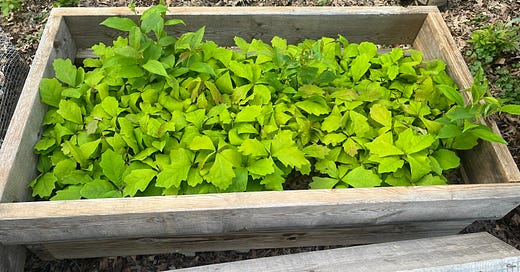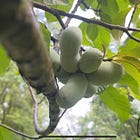“Even if I knew that tomorrow the world would go to pieces, I would still plant my apple tree.” – Martin Luther
“The greatest tree in the world started as a tiny seed.”
— St. John Chrysostom
In the world of trees, not all roots are created equal—and neither are the ways we grow and plant them. Whether you’re reforesting a flood-prone field, planning a city block's green canopy, or adding fruit trees to your orchard, the decision between bareroot and container-grown plants will impact the long-term health, growth, and ecological footprint of your landscape.
This issue explores how different planting methods shape not just trees, but the ecosystems and systems we build around them.
🌳 Field Lessons: Survival and Growth in Flood-Prone Conditions
A comprehensive study on Nuttall oak at the Lake George Wildlife Restoration Project in Mississippi compared bareroot, container-grown, and direct-seeded trees across planting dates and flood conditions. The results were striking:
Container-grown seedlings had the highest survival (>80%) across all planting times—even June, after flooding.
Bareroot survival plummeted to below 25% in March and June plantings, due largely to declining root viability from prolonged cold storage.
Bareroot seedlings experienced significant stem dieback and were shorter after one year than when first planted.
Container seedlings retained their height and showed better root resilience, likely thanks to their fibrous root systems and protection from transplant shock.
These findings reinforce one key point: timing, storage, and planting technique can make or break your trees’ early success—especially in stressed environments.
Read more here!
🏙️ Urban Forestry: Production Systems and the Root of the Problem
Urban trees face unique challenges—compacted soils, water stress, nutrient loss, and pollution. A review of nursery production systems in urban contexts showed that:
Containerized trees often develop circling roots that can eventually girdle and kill the tree years after planting.
Bare-root and in-ground fabric systems promote more natural root architecture and allow roots to spread symbiotically through living soil.
The survival and health of urban trees depend on how well the production method supports root development, not just early visual appeal.
Many production systems prioritize transportability and shelf life over long-term plant health, leading to short-lived urban trees and increased maintenance costs.
Read more here.
🛠️ The Backyard Perspective: A Grower’s Call to Conscience
As Akiva Silver of Twisted Tree Farm in New York puts it, bareroot trees are not convenient—they’re real. In his words:
"The difference is huge… Bare root trees are not convenient, they are real, they make sense for the grower, and are cheaper."
Silver paints a vivid contrast between bareroot trees grown in living soil, nourished by compost and mulch, and potted trees raised on chemical fertilizers in sterile media, often ending up root-bound in plastic containers outside big-box stores.
He points out:
Bareroot trees develop strong, fibrous root systems naturally aligned with their environment.
Potted trees, often force-fed nitrogen-heavy fertilizer, make lush top growth at the expense of root integrity.
Plastic pots, peat-based mixes, and synthetic fertilizers contribute to environmental degradation—from algae blooms to greenhouse gas emissions.
Bare root planting is seasonal, but sustainable. Potted plants are always available, but their convenience comes at a hidden cost.
Silver reminds us that plants are products of systems, and the system we choose to support matters—economically, ecologically, and ethically.
Read more here.
🌱 So, Which Is Better? It Depends on What You Value
🌿 The Bottom Line
When it comes to growing trees, what you don't see matters most. The root system—and the method used to develop it—defines how a tree grows, survives, and contributes to its environment.
If your priority is convenience, container-grown trees will fit the bill. But if you're aiming for soil health, long-term tree survival, and a lower environmental impact, bareroot trees are the clear winner.
🌍 As Silver puts it, our awareness shapes the world. Nurseries will sell what people are willing to buy. If we demand better systems—for our soil, our cities, and our future—the industry will adapt.
Community Corner
This section is all about you — your insights, feedback, and ideas. I love featuring your past comments and learning what’s resonating most. Your input plays a big part in shaping the future of this newsletter.
Looking ahead, I have three topic ideas in the works — and I’d love to know which one excites you most! Let me know what you'd like to see next.
Let me know which one you’d like to read next by casting your vote and/or leaving a comment—I always enjoy hearing your thoughts!
Crop Profile Directory
If you're just joining us — or if you enjoyed this issue and want to explore further — check out the three most popular crop profiles from our recent series. Take a look and let me know your thoughts!
Thank you for being part of this journey — exploring edible plants, sustainable practices, and the simple joy of nurturing local flora.
I can’t wait to hear your thoughts and ideas. I’ll see you back here next week!
Until then — happy planting,
Much love
Many blessings
Travis
P.S.
If you’re enjoying the newsletter and want to support its growth, I’d be truly grateful if you shared it with a friend, neighbor, or follower who might find it valuable.
Word of mouth is how this community grows — your recommendation could inspire someone else to start growing food and making a difference right where they are.










I live in a colder zone in Canada and my soil is a heavy clay. Every year I order more bare root fruit trees. I have now planted around 100 bare root trees (apple, cherry, pear, etc) and have less than a 10% survival rate putting bare root directly into the ground. I have changed that strategy into planting the bare root into a container for the first year, letting the roots get a chance to establish themselves, then planting that the following spring. So far the success rate with that enhancement is over 90%. I have a cold climate, no topsoil, and heavy clay. I have found over the last couple decades that a lot of planting instructions that work great in warmer and well drained soils are fatal for that kind of environment.
I put in some bare-root trees on the far side of the property where there is no water. I have to truck jugs of water over there periodically. Most seem to be alive still but I really need to figure out some kind of irrigation that doesn't cost hundreds of dollars.